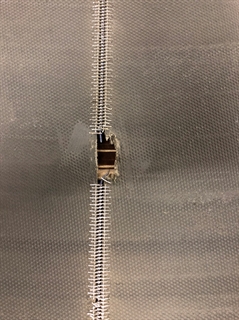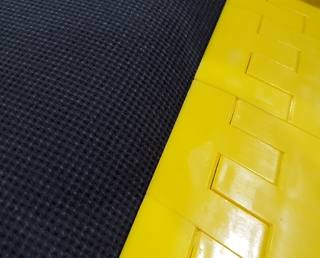Logistics Spotlight: The Top Three Ways to Destroy a Perfectly Good Conveyor Belt on Your Parcel Handling System
Now that the holiday season is over, there’s no better time to think about how to improve your belt conveyor system than right now. After all, Cyber Monday is not the time to ponder if preventative maintenance would have been a good idea before all those orders come in and all those packages come roaring through your parcel, warehousing, or distribution facility.
Question: Have you ever wondered how you could get more running life out of your conveyor belt? Longer belt life can mean more consistent and predictable conveyor run times. This equates to greater levels of output/production over the useable life of the conveyor belt.
Here’s a better question: Have you ever wondered how to NOT get more running life out of your conveyor belt? Probably not. But don’t worry because we have. Here are five surefire ways to lower your sortation or production output by simply ignoring your conveyor system:
 1. Belt failure due to broken hinge pins. Broken hinge pins in your mechanical splice will definitely lower belt life. Think of a hinge pin very much the same way you would think of door hinges. If the hinge pins are broken, bad things will happen. With a door, a broken hinge pin will cause it to fall down on you. With a conveyor belt, mistracking and potential splice failure can occur. A quick and careful inspection of your mechanical splices on a regular basis can allow you to replace a broken hinge pin before it becomes a larger problem.
1. Belt failure due to broken hinge pins. Broken hinge pins in your mechanical splice will definitely lower belt life. Think of a hinge pin very much the same way you would think of door hinges. If the hinge pins are broken, bad things will happen. With a door, a broken hinge pin will cause it to fall down on you. With a conveyor belt, mistracking and potential splice failure can occur. A quick and careful inspection of your mechanical splices on a regular basis can allow you to replace a broken hinge pin before it becomes a larger problem.
But what if the pin is not broken? How do you tell if it is worn enough to be scheduled into the preventative maintenance log for change out during the next maintenance shut down? For hinge pins that have a plastic or nylon coating over the steel core, a good rule of thumb is to schedule in a change when the coating is worn through 25% or more. Waiting longer can result in more difficulty when in removing the worn pin, or a broken pin and associated splice damage.
If you are looking to extend hinge pin wear life, consider switching from a standard nylon coating to a more durable coated pin like the Anker® DuraStainless™ Hinge Pins Its hybrid coating is designed to wear up to 10 times longer than traditional nylon coatings before reaching the 25% wear threshold.
2. Endless finger splices giving you trouble? Similar to a broken hinge pin, a failing finger splice is a recipe for production disaster on warehouse conveyor systems if not attended to in fairly short order. Once a finger splice begins to fail, the loosened fingers can begin to catch on conveyor componentry, resulting in an acceleration of the splice failure. Finger splices failing at the edges can cause belt tracking issues, which in turn, can cause additional damage to the failing splice and even long term belt failure. Failing finger splices are fairly easy to spot. When a finger splice begins to fail, a finger or two will separate from the belt surface. The loosened fingers will look like triangle-shaped material protruding from the belt surface. If you see this, it is time to schedule in a replacement splice belt repair or belt replacement at the next maintenance shut down.
The best defense to premature finger failure is to make sure the splice is made correctly, and perfectly, the first time. The Novitool® Aero® Splice Press from Flexco is the industry leader for creating the highest quality splice achievable while doing so in the shortest amount of time with a quality conveyor belt press.
3. Loose, bent, broken, or missing conveyor transfer plates can also lower a belt’s expected usable life. A loose or bent transfer plate can cause package damage. Damaged packages can spill contents onto the belt. The resulting foreign object debris (FOD) can become lodged in a loose or ill-fitting transfer plate. Imagine a sharp screw or bolt being tightly lodged between the transfer plate and the moving conveyor belt. Pretty soon you have a longitudinal tear in the belt, or worse, a completely split belt that creates two narrower conveyor belts. Belt repair is the last thing you need to be worrying about.
 Traditional UHMW plates, when fit properly, do offer a decent level of protection. Over time, however, this style of T-plate can wear, warp, or deflect. For better protection and virtual elimination of longitudinal tears cause by lodged debris, consider Flexco Segmented Transfer Plate technology. Interlocking individual segments that snap onto a common support bar are allowed to lift or deflect if debris were be become lodged. This allows the debris to drop harmlessly through the transfer. In a more severe situation, the affected segment(s) can remove itself from the support bar, allowing the debris to pass. The replacement of the segment with a new one takes seconds, allowing the segmented transfer plate to function like new again.
Traditional UHMW plates, when fit properly, do offer a decent level of protection. Over time, however, this style of T-plate can wear, warp, or deflect. For better protection and virtual elimination of longitudinal tears cause by lodged debris, consider Flexco Segmented Transfer Plate technology. Interlocking individual segments that snap onto a common support bar are allowed to lift or deflect if debris were be become lodged. This allows the debris to drop harmlessly through the transfer. In a more severe situation, the affected segment(s) can remove itself from the support bar, allowing the debris to pass. The replacement of the segment with a new one takes seconds, allowing the segmented transfer plate to function like new again.
An additional advantage to this flexible design is that it allows the transfer plate to be installed with light contact at the surface of the belt with the segments flexing on the bar as splices effortlessly passes under them.
The moral of the story here is that this business is never slow, but there are times when things aren’t as busy. Inspecting your conveyor belts and components during slower times of the year can be the secret to peak performance when you need it most. Stay tuned to our blog for more tips on how to make sure your belts are running smoothly throughout the year.
Authored by: Todd Stewart, Industry Manager
Stewart has been with Flexco for 29 years, working in various roles from customer service, to manufacturing, to training and new product development. As Industry Manager, Stewart thoroughly researches target industries, creating programs to support each industry and identifying customer issues, as well as potential product solutions. Stewart currently leads the development of the Parcel Handling Industry Program and is responsible for ensuring that Flexco is positioned to serve the needs of our global customers. Stewart earned a bachelor’s degree in Marketing with a B2B specialty from Davenport University.
Subscribe to the Flexco Blog
Published Date
March 05, 2019Product Groups
- Belt Accessories
- Endless Splicing Systems
- Mechanical Belt Fastening Systems
Industries
- Parcel Handling
- Warehousing and Distribution
Issues
- Belt Damage
- Belt Wear
- Downtime
- Maintenance